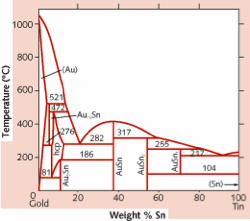Device thermal management has become more essential as packages run at higher frequencies and higher power levels. Designers are thinning their wafers with CMP, wet etching or back lapping type technologies, resulting in a thermal impedance between active circuitry and thermally dissipative packages. At Palomar Technologies, we have successfully addressed these commonly seen thermal management issues with an automated eutectic die attach method on the Palomar 3800 Die Bonder.
Automated eutectic die attach has literally become a hot topic in the past few years. Traditional epoxy materials are not as efficient as eutectic materials in conducting heat to keep ICs cool while meeting process capability requirements. Eutectic materials can maintain sufficient heat conduction for proper thermal management at die attach, even for high yields.
For years, 80/20 AuSn has been the eutectic material of choice having the lowest liquidus eutectic point of the hard solders at 280°C. But times are changing; AuSn reflow is simply too hot for many packages, especially those with multiple die, and the time at an elevated temperature strains the ICs, permanently altering their performance. We’re seeing a trend towards soft solders from AgSn to lower temperature exotics such as Indium. Eutectic points are an excellent solution to satisfy worse case time-at-temperature packaging requirements.
Common methods of eutectic die attach:
- Traditionally used steady state heaters and scrub in the X/Y plane to minimize voiding
- Pulse heat processes and scrub in X/Y and Z axes—much higher placement accuracy attachment as the automated system does not let go of the device being attached until the temperature at the eutectic interface is into the plastic or solid region of the material’s phase diagram (see Image 1)

Image 1: Au/Sn eutectic phase diagram. Image courtesy of Advanced Packaging
Hot Rail Handling
“Hot Rail” material handling systems can slowly bring the packages near the eutectic point in Auer type boats or flat carriers, and is very successful for high yields. The packages then enter the attachment nest. Cover gas is applied and the dies can be attached with either the traditional steady state processes or pulse heat processes.
Oxygen Abatement for Eutectic Die Attach
Displacing oxygen is a strict requirement for all alloys that have oxidation potential. In a perfect scenario, a reducing gas is used—typically 95/5 N2/H2, or even higher concentrations of hydrogen to increase the reduction process. In many cases, the solution seems to be simple oxygen abatement, displacing atmospheric oxygen by any inert gas such as pure N2 or Argon. While forming gasses may slightly reduce void formation and increase the appearance of the die’s fillet, it is not necessary for a high-reliability/low-void eutectic interface. Nitrogen is more cost effective while sufficiently controlling oxidation potential.
At this time, fluids such as epoxies cannot address higher thermal conduction. Automated eutectic die attach remains the only viable high-process capability packaging solution.
Want to Learn More About Eutectic Die Attach?
----
Bradley Benton
Western Regional Sales Manager
Palomar Technologies